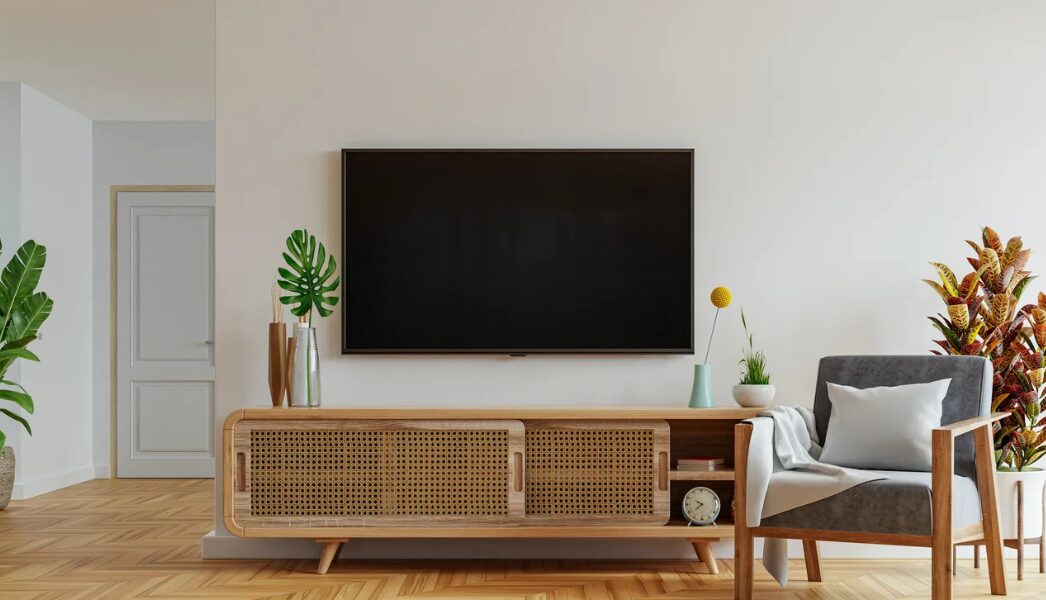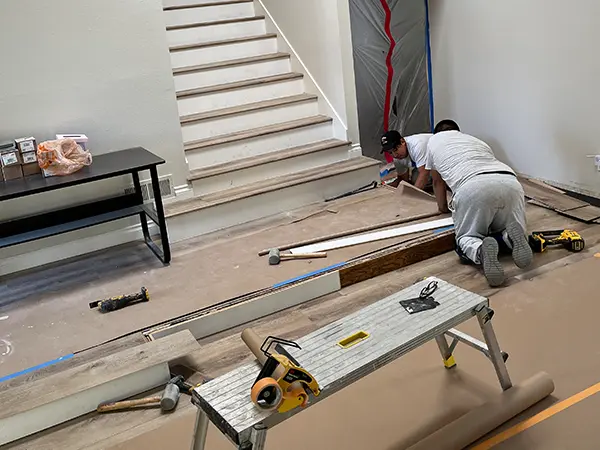The Ultimate Guide to Mounting Your TV on the Wall

Mounting a TV on the wall can enhance your viewing experience, save space, and give your room a sleek and modern look. However, proper installation is key to ensuring safety, stability, and optimal viewing angles. In this comprehensive guide, we’ll explore everything you need to know about mounting your TV on the wall, including tips, tricks, and best practices to achieve the perfect setup.
Contents
Assessing your TV
It’s crucial to assess your TV’s specifications and compatibility with your wall. In this guide, we’ll explore how to evaluate your TV’s size, weight, and mounting compatibility to ensure a successful wall-mounting experience.
TV Size Matters
Measure your TV’s screen size diagonally from corner to corner. Consider the available wall space and viewing distance to determine the ideal screen size for your room.
Take into account the TV’s dimensions, including width and height, to ensure it fits proportionally on the wall and aligns with your aesthetic preferences.
Understanding TV Weight
Check your TV’s user manual or specifications to determine its weight. Most modern TVs are relatively lightweight, but larger models may be heavier.
Ensure that your chosen wall mount is rated to support the weight of your TV. Exceeding the weight limit can compromise the mount’s stability and safety.
Assessing Mounting Compatibility
Determine the VESA (Video Electronics Standards Association) mounting pattern of your TV. This standardized pattern consists of the horizontal and vertical spacing of the mounting screw holes on the back of the TV.
Match the VESA pattern of your TV to the compatibility of the wall mount. Most mounts specify the range of VESA patterns they support, ensuring a secure fit for your TV.
Consider additional factors such as the type of mount (fixed, tilting, full-motion) and its compatibility with your TV’s design and features.
Checking Wall Construction
Assess the type of wall you’ll be mounting your TV on, whether it’s drywall, concrete, brick, or plaster. Different wall types may require specific mounting hardware and techniques.
Locate wall studs using a stud finder to ensure a secure and stable mounting surface. Studs provide stronger support than hollow wall spaces and are essential for heavy TVs.
Considering Viewing Height and Angle
Determine the optimal viewing height for your TV based on seating arrangements and room layout. The center of the TV screen should be at eye level when seated for comfortable viewing.
Choose a wall mount that allows for height adjustment and tilt angle to achieve the desired viewing position.
TV Wall Mount Installation
Mounting your TV on the wall can enhance your viewing experience and free up valuable floor space in your living room or entertainment area. However, proper preparation is essential to ensure a successful and safe installation. So consider hiring handyman services to ensure proper installation.
Gather the Necessary Tools and Equipment
- Stud finder
- Level
- Measuring tape
- Drill and drill bits
- Screwdriver or screw gun
- Pencil or marker
- Masking tape (optional)
- Power extension cord (if needed)
Read the TV Manual and Mounting Instructions
- Review the user manual of your TV to understand its specifications, including size, weight, and VESA mounting pattern.
- Familiarize yourself with the mounting instructions provided by the TV manufacturer and the wall mount manufacturer. Pay attention to any specific requirements or recommendations.
Choose the Mounting Location
- Determine the ideal location for mounting your TV, considering factors such as viewing angle, room layout, and seating arrangements.
- Locate wall studs using a stud finder to ensure a secure mounting surface. Mark the stud locations using a pencil or masking tape.
Assess Wall and Mount Compatibility
- Determine the type of wall you’ll be mounting the TV on (drywall, concrete, brick, etc.). Different wall types may require specific mounting hardware and techniques.
- Check the weight capacity and compatibility of the wall mount with your TV’s size and VESA mounting pattern. Ensure that the mount is suitable for the wall type and stud spacing.
Plan Cable Management
- Consider how you’ll manage cables and wires for a clean and organized look. Determine the best route for routing cables from the TV to power outlets and other devices.
- Choose cable management solutions such as cable raceways, in-wall cable kits, or decorative covers to conceal cables effectively.
Clear the Installation Area
- Remove any furniture, decorations, or obstacles from the wall and surrounding area where you’ll be installing the TV mount. Ensure there’s enough space to work comfortably.
Prepare the TV and Mount
- Carefully unpack the TV and wall mount, ensuring that all components are accounted for and in good condition.
- Assemble the wall mount according to the manufacturer’s instructions, attaching any brackets, arms, or hardware as needed.
Double-Check Measurements and Alignment
- Use a level and measuring tape to ensure accurate placement and alignment of the wall mount. Mark the mounting hole locations on the wall with a pencil or marker.
Ensuring Safety and Stability
Ensuring safety and stability is paramount. Proper weight distribution, cable management, and stability checks are essential to prevent accidents and ensure a secure installation.
Centering the TV on the Mount for Balance
- Position the TV on the mount so that it is centered both horizontally and vertically. This ensures even weight distribution and prevents undue stress on the mount and wall.
- Use a level to confirm that the TV is perfectly aligned. Adjust the mount if necessary to achieve balance.
Securing Cables
- Route cables and wires behind the TV and along the wall to minimize clutter and tripping hazards.
- Use cable clips, zip ties, or adhesive-backed cable raceways to secure cables in place and prevent them from dangling or tangling.
- Ensure that cables are not pinched or kinked, which could damage them or affect signal quality.
Checking Stability
- Apply gentle pressure to the TV in various directions to check for wobbling or shifting. A securely mounted TV should feel stable and firmly attached to the wall.
- Inspect the mounting hardware and connections for any signs of looseness or instability. Tighten screws and bolts as needed to ensure a secure fit.
- Monitor the TV for any signs of sagging or tilting over time. If necessary, readjust the mount or seek professional assistance to address stability issues.
Additional Safety Measures
- Anchor the TV mount to wall studs whenever possible for maximum stability. Use wall anchors or toggle bolts for mounting on drywall if studs are not available.
- Follow the manufacturer’s weight capacity guidelines and recommendations for your specific TV and mount model.
- Educate household members about the importance of TV safety, especially if there are children or pets in the home. Encourage safe handling and avoid placing heavy objects on or near the TV.
Troubleshooting Common Issues
Mounting the TV on the wall often comes with its own set of challenges. Uneven walls, stud placement, cable management, and viewing angle issues can all arise during installation.
Dealing with Uneven Walls
Use a stud finder to locate wall studs for secure mounting. However, if studs are unevenly spaced or not located where desired, consider using a wall-mounting bracket designed for non-standard stud placement.
Alternatively, use drywall anchors or toggle bolts to anchor the mount securely to the wall, distributing the weight of the TV evenly.
For extremely uneven walls, consider installing a piece of plywood or a mounting board to create a flat and stable surface for mounting the TV.
Addressing Cable Management Dilemmas
Determine the best route for cables to minimize visibility and tripping hazards. Use cable raceways, conduit, or in-wall cable kits to conceal and organize cables effectively.
Consider using wireless HDMI transmitters to eliminate the need for long HDMI cables running from the TV to other devices.
If cable lengths are insufficient, use cable extensions or adapters to bridge the gap between devices without compromising cable management.
Revising Mounting Position
Assess the TV’s mounting position and viewing angle from various seating locations in the room. Adjust the mount’s height or tilt angle to optimize the viewing experience for all viewers.
Use a TV mounting template or mock-up to visualize the TV’s position on the wall before drilling holes or making adjustments.
Consider mounting the TV on an articulating or tilting mount to provide flexibility in adjusting the viewing angle based on seating arrangements and lighting conditions.
Additional Tips for Troubleshooting
Use a level to ensure the TV is mounted straight and aligned with the room’s layout.
Check the weight capacity and compatibility of the wall mount with your TV model to avoid overloading or strain.
Consult professional installers or technicians if you encounter challenges beyond your expertise or feel unsure about the installation process.
Alternative to Wall Mounting
While wall-mounting a TV offers space-saving benefits and a sleek aesthetic, it’s not always the most practical or feasible option for every home. Fortunately, TV stands provide a versatile alternative that combines style, functionality, and convenience.
Flexibility in Placement
Unlike wall-mounted TVs, which are fixed in one location, TV stands offer flexibility in placement. You can easily move the stand to different rooms or positions within a room to accommodate changing furniture arrangements or viewing preferences.
No Wall Damage or Installation Hassle
Mounting a TV on the wall requires drilling holes, locating studs, and potentially damaging walls. With a TV stand, there’s no need for installation, making it a hassle-free option, especially for renters or those who prefer not to make permanent alterations to their living space.
Stylish Design Options
TV stands come in a variety of styles, materials, and finishes to complement any décor. Whether you prefer a modern, minimalist look or a rustic, farmhouse vibe, there’s a TV stand to suit your taste and aesthetic preferences.
Storage and Organization
Many TV stands feature built-in shelves, cabinets, or drawers, providing ample storage space for media devices, gaming consoles, DVDs, and other accessories. This helps keep your entertainment area neat and organized, reducing clutter and enhancing visual appeal.
Cable Management Solutions
TV stands often include integrated cable management features such as cable channels, wire baskets, or rear cable access ports. These solutions help conceal and organize cables, reducing tangling and creating a cleaner, more streamlined look.
Accessibility and Ergonomics
With a TV stand, you can position your TV at the optimal height and viewing angle for comfortable viewing. This is especially important for larger TVs or when multiple people are watching from different seating positions.
Compatibility with Various TV Sizes
TV stands are available in different sizes and configurations to accommodate a wide range of TV sizes and models. Whether you have a small, compact TV for a bedroom or a large, widescreen TV for a living room, there’s a TV stand that fits your needs.





